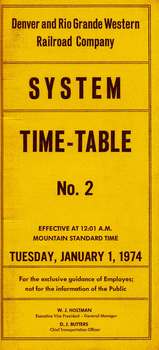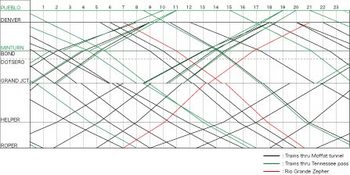SYSTEM TIME-TABLE (D&RGW Employee Time Table) [Column_Printed Matter]
 : cover of ETT
: cover of ETT"SYSTEM TIME-TABLE No. 2", 55 pages, 1974
This is the employee time table of Rio Grande.
As usual, we can find the train schedule. Here, the Rio Grande dispatches 12 westward trains and 6 trains eastward west of Grand Junction. Eastward trains might run in sections, one bound for Denver and the other for Pueblo. That makes the formula.
Most of the eastward trains stop at Grand Junction about an hour and a half. They might have some switchings and/or adding at the yard. Contrary, most of the westward trains only have brief stops.
Here, I made a diagram from the train schedule.
We can find that the westward and eastward trains tend to run in "elephant style", east of Grand Junction. I don't know why but thanks to the schedule, I could catch 3 trains in an hour (and I missed the Zephyr!) around Glenwood Canyon in the afternoon of 1971.
The train I caught around Glenwood Canyon;
http://riogrande.blog.so-net.ne.jp/2010-02-09-5
http://riogrande.blog.so-net.ne.jp/2010-02-09-6
http://riogrande.blog.so-net.ne.jp/2010-02-09-7
 : diagram made from the time table
: diagram made from the time tableBy the way, on the pages instructing mileages and stations along the line, there are some symbols next to the name of stations, like "MINTURN DBFKRSWY".
These symbols indicate;
B: Bulletins and circulars
D: Day train order office
DN: Day and night train order office
F: Fuel Station
J: Junction Point
K: Standard clock
N: Night train order office
O: Track Scales
P: Telephone
R: Wayside radio station
S: Sand
T: Turntable
W: Water station
Y: Wye
Besides these, some stations have these items for emergency use.
・Car Skids
・Rerailing Frogs
・Slewing Cables
It resembles to Michelin Guide. 3-star stations maybe the "worth the journey" stations for us, the fan. But the "J" station would be the station which attracts the crews best. It is said that "THE POINT IS NOT WHERE YOU WORK - IT'S HOW YOU WORK".
 : page 20-21 of the time-table
: page 20-21 of the time-tableD&RGWのEmployee Time Table(業務用時刻表)である。といっても基本的にはdispatcherの指令の下に運行されるので、日本のそれのように逐一詳細な時刻が載っている訳ではない。載っているのは旅客列車(Rio Grande Zephyr)およびscheduled trainのみである。それもダイヤグラムではなく表として示される。Extra(いわゆる臨時)やlocalなどの列車は載っていない。
D&RGWはDenverおよびPuebloからの路線がGrand Junctionの東に位置するDotseroで合流しSalt lake City(Roper Yard)に至る、Y字を横倒しにしたような形の路線を幹とする鉄道である。DenverおよびPueblo発の西行きが計12本あるのに対し、Salt lake City発の東行きは半分の6本になっている。
ETTによれば西行きの列車はそれぞれSalt lake Cityに直通するのに対し、東行きの列車は、途中のGrand Junctionに設けられたヤードでDenver行きおよびPueblo行きに仕立て直されるようだ。したがって、東行きの列車はSalt lake Cityから「run in sections」、Denver行きの列車およびPueblo行きの列車が続行していることが推察できる。
さて、時刻表には駅名と里程が示されている。駅名の横に"MINTURN DBFKRSWY"というように、符号がいくつか記されている駅がある。この符号の意味は次のようになっている。
B: Bulletins(通達) and circulars(便覧)
D: Day train order office
DN: Day and night train order office
F: Fuel Station
J: Junction Point(区界、乗務交替地)
K: Standard clock
N: Night train order office
O: Track scales
P: Telephone
R: Wayside radio station
S: Sand
T: Turntable
W: Water station
Y: Wye
別のページには、非常時用の器具類が常備されている駅の一覧が載っている。器具類とは、
Car Skids(これはどんなものだろう?)
Rerailing Frogs
Slewing Cables(これもどんなものだろう? 単なるロープ?)
である。これらを見ていると、まるでミシュラン・ガイドのように思えてくる。ミシュラン・ガイドでは星3つは「そのために旅行する価値がある卓越した料理」の出る店だそうだが、乗務員にとっては星の数よりも、やはりJ、つまり乗務の終わる「店」がもっとも魅力的に思えるだろう。別のページに記されている標語には「どこで働くかではなく、いかに働くかが重要だ」とある。(僻地だからといって)くさるな、ということだろうか。
2010-11-15 11:11
コメント(0)
トラックバック(0)




コメント 0